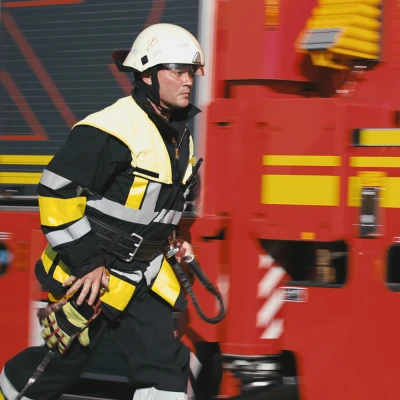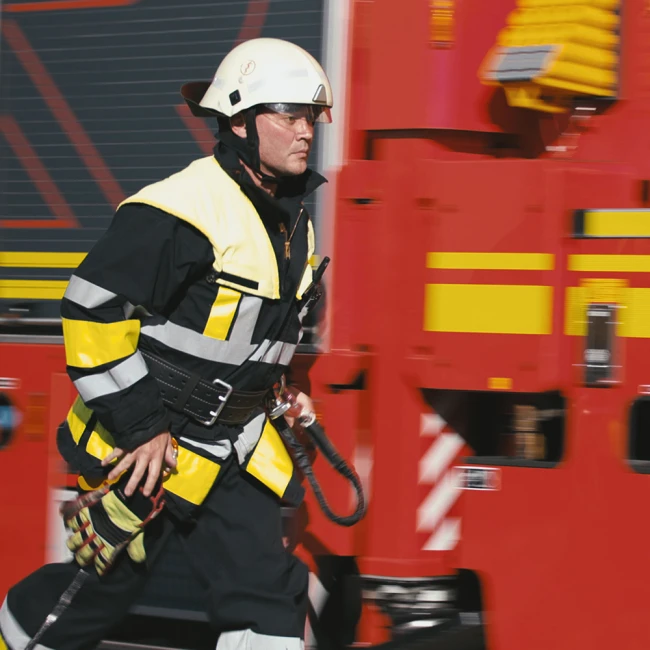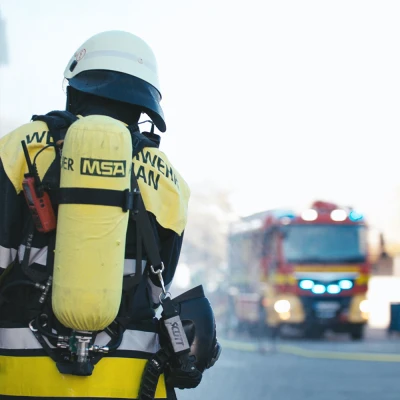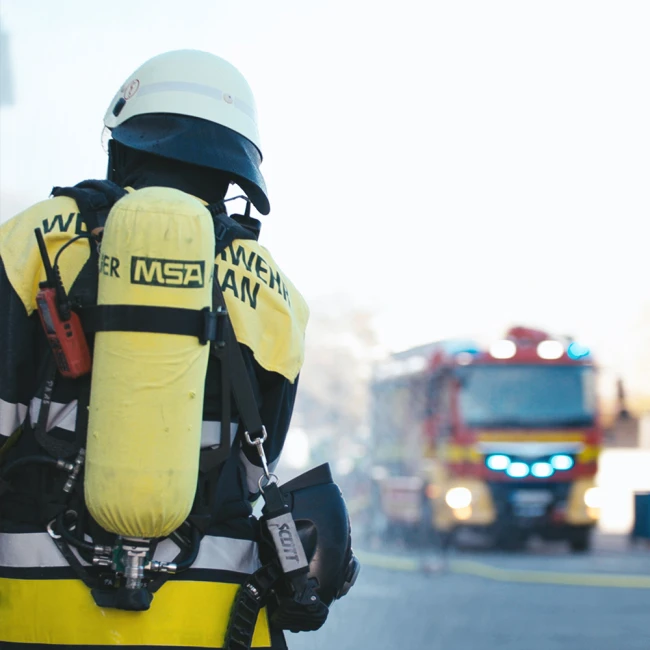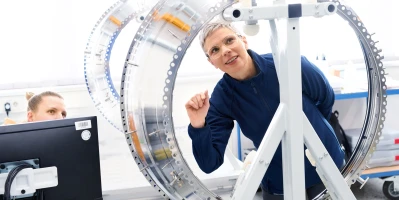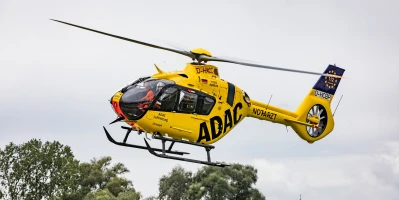people
Always on duty: The MTU and MAN fire department
Forget about turning on the siren, putting out the fire and then heading back to the garage: The day-to-day operations of the MTU/MAN fire department are far more complex than that.
author: Thorsten Rienth | 4 mins reading time published on: 10.09.2020
author:
Thorsten Rienth
writes as a freelance journalist for AEROREPORT. In addition to the aerospace industry, his technical writing focuses on rail traffic and the transportation industry.
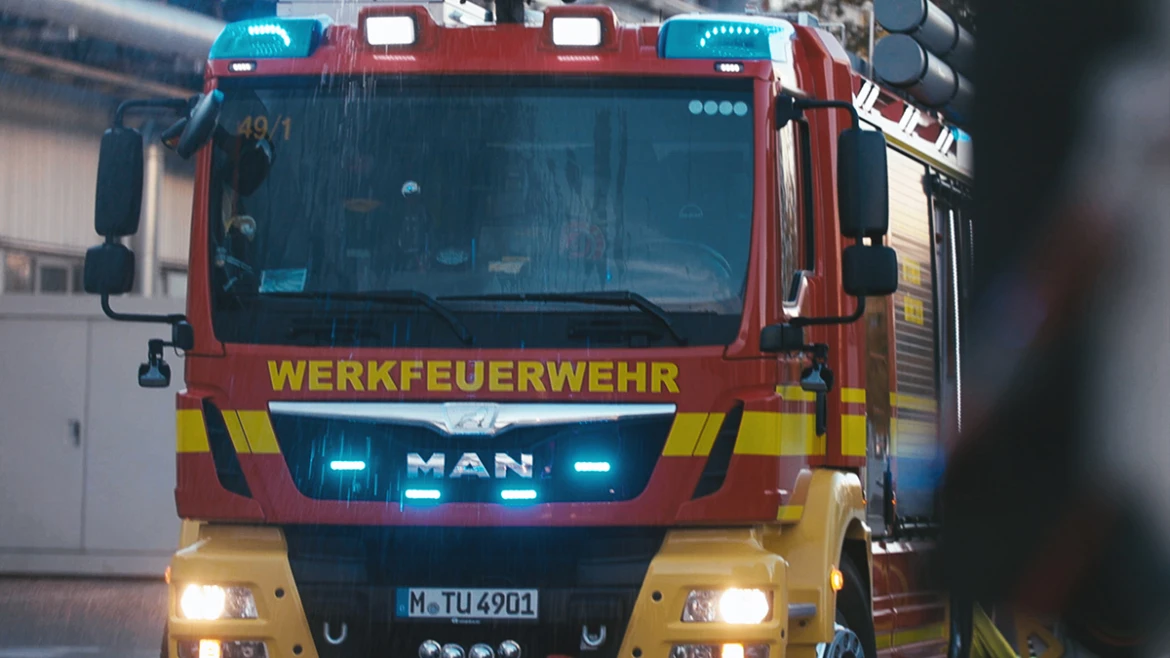
Everything comes together in the alarm center—through telephones and microphones, via lights and switches, on keyboards and monitors. Digital maps flicker on screens, a stylized depiction of the premises of MTU Aero Engines and MAN Truck & Bus in Munich. The two company sites lie adjacent, and the joint fire station of the MTU/MAN fire department sits right on the dividing line.

“In what we do, every second really does count.”
“We coordinated and successfully completed over 3,200 operations last year,” says Markus Schmid, fire department chief. These included firefighting and fire protection, technical assistance, hazardous materials, security services, rescue services and occupational health care. In the event of a particularly high number of emergencies in the surrounding area, the fire department also supports the nearby control centers.
For these cases, the person on duty in the alarm center sends out the ambulance. Munich’s motorway ring road runs only a few hundred meters south of the factory site. “The Munich Integrated Control Center coordinates the fire and rescue services in the area. When there’s an accident and our colleagues there see that we can get there fastest, they call us in. Our emergency paramedics take control at the scene of the accident until the regular emergency doctor arrives,” Schmid explains.
Turn on the siren, put out the fire, return: The exception, not the rule
The two companies have operated a joint fire department since 1963, as their needs regarding fire protection and hazard prevention are very similar.
However, the classic firefighting activities of the past—turning on the siren, putting out the fire and driving back again—now make up only a small part of the department’s work. Only four percent of operations now involve traditional firefighting. “The demands on modern fire departments have changed enormously,” Schmid says.
MTU/MAN fire department: The two companies have operated a joint fire department since 1963. They successfully completed over 3,200 operations last year.
Act rather than react—this strategy is underpinned by a preventive approach to emergencies. As many emergencies as possible should be prevented from the outset, by means of preventive fire protection or security services, for example. In addition, there are now almost 35,000 sensors distributed across the two company premises as part of fire alarm and gas detection systems. Each one is connected to the alarm center. “A sophisticated system regulates maintenance and functional checks,” Schmid explains.
Five minutes to reach any location on the premises
Hardly anything happens on the premises without the fire department being involved in some way. What has to be observed with regard to the new hazardous material requirements? Does the aerial rescue platform reach to the top floor of a new building? And what does all this mean for emergency access routes, both during the construction phase and afterward? Once the alarm center has received an emergency call, the fire department has five minutes to reach the scene, wherever that might be on the premises. As Schmid says, “In what we do, every second really does count.”
This is an especially pertinent point at the moment. MTU and MAN plan to completely renovate the fire department building by the end of the year; some of its walls date back to the 1930s. This undertaking particularly concerns the workshops, alarm center and vehicle hall. The goal is to always be state of the art, so the renovation package also includes construction of a new disinfection and hygiene hall. “Smoke can contain carcinogenic substances that are deposited on appliances, vehicles and medical equipment,” Schmid says. That’s why the new hall provides professional cleaning facilities. The main idea here is to minimize risk. In addition, the 46 members of the fire department will receive new communal areas.
“Naturally, we also ensure the safety of the employees and the facilities, including during the construction work,” Schmid says. “And that will be 24 hours a day, 365 days a year.”
Watered down: Only four percent of operations now involve firefighting. The classic firefighting activities of the past now make up only a small part of the department’s work.
Two highlights from the state-of-the-art fleet
MAN TGS 26.440 (aerial rescue platform 42) – for fires on upper floors or, for example, rescue operations in large industrial buildings
Aerial rescue platform 42: A 1,200-liter water tank and a foam concentrate tank with a capacity of 200 liters are permanently installed.
Powered by a 420 hp engine, the vehicle has a permissible total weight of 26 metric tons. At full extension, its aerial rescue platform measures 42 meters. The basket on the end of the platform is designed for a maximum load of 500 kilograms, and the electric fire monitor can discharge up to 3,800 liters of water per minute. A permanently installed normal pressure pump transports the water upward at a pressure of eight bar via a pipeline installed on the telescopic mast. Other permanent fixtures are a 1,200-liter water tank and a foam concentrate tank with a capacity of 200 liters.
MAN TGS 18.340 4x2 BL (universal rescue unit firefighting vehicle) – one of the most versatile firefighting vehicles there is. It reflects the shift in the scope of operations from extinguishing fires to rendering technical assistance
Universal rescue unit firefighting vehicle: The most versatile firefighting vehicle can hold up to 3,500 liters of water, 500 liters of foam concentrate, and 240 kg of carbon dioxide.
This universal rescue unit firefighting vehicle weighs up to 18 metric tons. The comparatively small vehicle is so heavy because of its equipment for technical assistance, which includes a spreader, cutter, lifting bags, outrigger, rescue platform, multi-purpose hoist, a permanently installed 60 kVA generator and various extinguishing agents (water, foam, CO2). These can be managed via the pump control panel at the rear, and the water cannon on the roof can even be operated remotely while driving.



